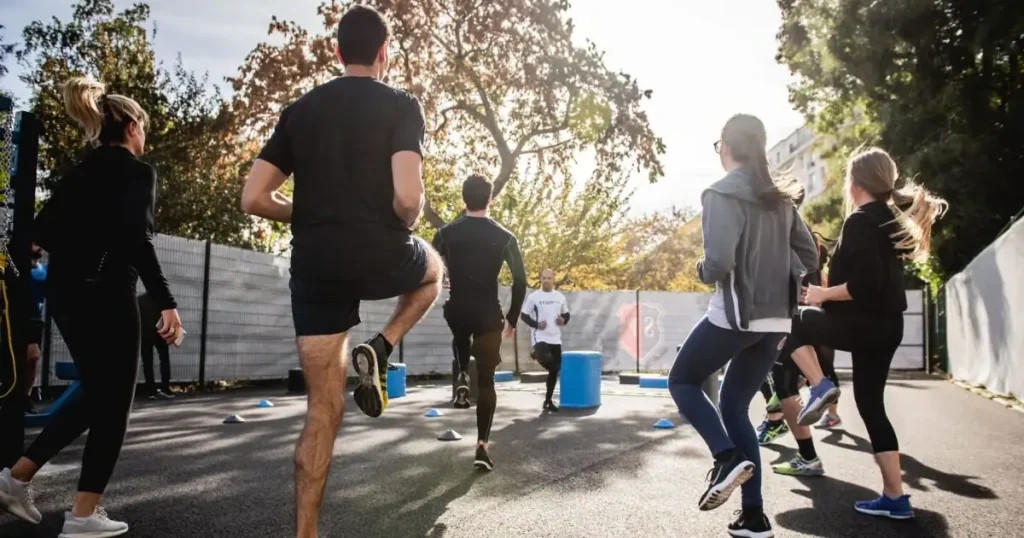In today’s world, people are becoming more aware of the importance of staying healthy. We know that exercise and physical activity are essential for our overall well-being, not just for looking good or being good at sports. They can help prevent diseases and manage existing health conditions.
By understanding and promoting the connection between fitness and healthcare, we can create healthier communities and reduce the burden of chronic diseases on healthcare systems worldwide. In this discussion, we will explore the many benefits of fitness in healthcare and look at ways to make it easier for people to include exercise in their healthcare routine.
Table of Contents
The Impact of Fitness on Healthcare
Staying active and exercising regularly can do wonders for your health. It can help keep you healthy and prevent many long-term health issues, such as diabetes, heart disease, and obesity. Studies have shown that physically active people are less likely to get sick or die early than people who don’t exercise. Exercise can also help boost your immune system, make you feel better mentally, and reduce the risk of depression and anxiety.
Discussing the Positive Effects on Health:
Staying physically active and exercising regularly is good for you. It can help your heart, metabolism, and muscles stay healthy and strong. When you exercise, your body releases chemicals that make you feel happy and sound, which can also help with mental health. Being fit can also help you manage your weight and reduce your risk of getting sick from being overweight.
Understanding Economic Implications:
Staying fit and active benefits our health and significantly impacts our economy and healthcare system. Encouraging people to lead an active lifestyle can help save a lot of money that would otherwise be spent on treating chronic diseases and other related health issues. By investing in fitness promotion initiatives, we can reduce the financial burden on healthcare systems and promote more sustainable healthcare practices.
Real-Life Success Stories
Jane’s Journey to Health:
Jane, a 45-year-old office worker, struggled with obesity and type 2 diabetes. With her doctor’s guidance, she began a tailored exercise program combining moderate cardio and strength training. Over a year, Jane lost 50 pounds, reduced her blood sugar levels to normal, and significantly improved her overall health. Her story illustrates the profound impact of integrating exercise into daily routines.
Community Transformation in Springfield:
The small town of Springfield faced high rates of heart disease and obesity. A community initiative introduced walking clubs, free fitness classes, and nutrition workshops. Within two years, the town saw a 20% reduction in obesity rates and improved public health metrics. This success story shows the power of collective action in promoting fitness.
Fitness as a Preventative Measure
Staying active and exercising regularly can help prevent many health problems. It’s like a shield that protects us against chronic diseases and is essential to taking care of our health. Being physically active can boost our immune system, improve our mental health, and reduce the chances of getting sick. This section discusses how exercise can help us stay healthy and avoid getting sick.
Boosting Immune Function:
Regular exercise can help your body fight sickness. Exercise strengthens your immune system and better protects you from getting sick. Making exercise part of your daily routine can help protect yourself from sickness and reduce how bad you feel if you get sick.
Promoting Mental Health:
Regular exercise can help improve mental health and well-being by reducing stress, anxiety, and depression. Physical activity releases neurotransmitters called endorphins that promote happiness and relaxation. Exercise can also enhance cognitive function, self-esteem, and body image, all contributing to overall mental wellness.
Preventing Chronic Diseases:
Staying fit and active can help prevent chronic diseases. Regular exercise can help you maintain a healthy weight, keep your blood sugar and pressure in check, and reduce your risk of type 2 diabetes, heart disease, and some cancers. By making physical activity a part of your daily routine, you can significantly lower your chances of developing such illnesses and enjoy a better quality of life.
Integrating Fitness into Healthcare Practices
Integrating fitness into healthcare practices is a new way to approach healthcare delivery. By combining fitness initiatives with conventional medical protocols, healthcare providers can address existing conditions and prevent future health problems. This section explores different strategies for incorporating fitness into healthcare practices, emphasizing the role of healthcare professionals in promoting physical activity.
Expert Insights
Dr. Emily Johnson, Cardiologist:
Exercise is a cornerstone of cardiovascular health. Regular physical activity strengthens the heart, lowers blood pressure, and reduces cholesterol levels. Patients who incorporate fitness into their routines often see marked improvements in their heart health and overall well-being.
Physical Therapist Sarah Lopez:
Incorporating strength training into exercise routines can prevent musculoskeletal issues, especially as we age. Strengthening muscles and bones reduces the risk of fractures and improves mobility and balance.
Mental Health Specialist Dr. Mark Allen:
Exercise is a natural antidepressant. Physical activity increases endorphin levels, which helps alleviate symptoms of depression and anxiety. I encourage patients to view exercise as a critical component of their mental health regimen.
Prescribing Exercise as Treatment:
Healthcare providers have an essential role in promoting fitness. They can prescribe exercise as part of treatment plans for patients with chronic diseases or health conditions. With personalized exercise regimens, healthcare professionals can help patients manage their health and improve their well-being. This approach can improve treatment outcomes and encourage a collaborative relationship between patients and healthcare providers.
Counseling and Education:
Healthcare professionals can help patients lead healthier lives by encouraging them to exercise regularly. By educating them about the many benefits of physical activity and offering tips on incorporating exercise into their daily routine, healthcare providers can empower their patients to make informed decisions about their health. They can also help patients overcome challenges, such as needing more time, money, or motivation.
Implementing Fitness Programs:
Hospitals and clinics can help patients stay fit and healthy by providing on-site fitness programs and services. This includes access to exercise facilities, fitness classes, and wellness resources. By doing so, healthcare organizations can create an environment that supports physical activity and encourages patients to stay active. These programs can be customized to suit patients’ different needs and made easy to access and affordable to ensure that everyone can participate and benefit from them.
Community Engagement and Public Health

People need to work together to promote fitness and improve public health. This means taking action as a community to encourage healthy habits and ensure everyone has access to the resources they need. In this section, we’ll discuss how communities can work together to promote physical activity and raise awareness about the benefits of being active.
Promoting Access to Fitness Facilities and Resources:
Efforts are being made to ensure everyone has access to fitness facilities and resources, regardless of where they live. Communities are working with local governments, nonprofit organizations, and private sector stakeholders to create initiatives that will help build and maintain recreational spaces, establish walking and biking trails, and provide affordable fitness programs for all residents.
Addressing Health Disparities:

Fitness programs based in communities can help address health disparities and reduce inequalities in healthcare access. These programs focus on providing resources to people who may not have easy access to them, such as those living in low-income communities, rural areas, or who are part of racial or ethnic minority groups. These initiatives aim to empower people to prioritize their health and well-being by offering culturally sensitive programming and outreach efforts.
Raising Awareness Through Public Health Campaigns:
Public health campaigns are a great way to tell people about the importance of staying active and healthy. These campaigns use different ways to spread the message, like social media, events, and community gatherings. They encourage people to change their lifestyle positively and add physical activity to their daily routine. These campaigns create a supportive environment that helps people prioritize their health and well-being.
Challenges and Barriers
Staying fit is essential for our health, but sometimes it can take effort to find the time or resources to exercise regularly. There are also times when we don’t feel motivated enough to get moving. This can be a big problem because it stops us from being active and healthy. In this section, we will look at the different reasons people find it difficult to exercise and explore ways to overcome these challenges. Doing so can create sustainable habits that promote physical activity and improve our overall health.
Identifying Common Challenges:
It’s important to know what problems people face when staying fit. Some of the most common issues are not having enough time because of work or other responsibilities, not having enough money to pay for a gym or equipment, and not having access to a fitness facility or program. Some people also have trouble staying motivated to exercise, either because they don’t enjoy it or because they don’t feel like they can do it.
Strategies for Overcoming Challenges:
We need a multifaceted approach that includes individual and systemic interventions to promote fitness engagement. Empowering people with knowledge and skills to overcome barriers and creating policies for affordable fitness facilities and walkable communities can help people prioritize physical activity.
Fostering a Culture of Support:
Creating a supportive and responsible community is essential for people who want to stay fit and healthy—connecting with others, getting encouragement, and having friends help you make it easier to stay motivated and committed to reaching your fitness goals. Also, using technology like fitness apps and online workouts can help make it more convenient and accessible to exercise regularly.
Future Directions and Recommendations
It’s essential to think about how we can make it easier for people to be healthy in the future. This means using new technology, finding better ways to give people healthcare, and creating rules that help people be more active. By doing these things, we can help more people be healthy and have a better life.
Harnessing Technological Advancements:
The rapid development of technology has opened up new possibilities for improving how we promote fitness and healthy lifestyles. By using wearable devices, mobile apps, and virtual reality, we can create fitness programs that give us personalized feedback, keep track of our progress in real time, and make working out more fun. Additionally, advanced technologies like data analytics and artificial intelligence can help doctors and other healthcare providers suggest more effective treatments tailored to our health needs and preferences.
Transforming Healthcare Delivery Models:
To ensure people’s health, we need to change the way we think about healthcare. Instead of only helping when someone is sick, we need to focus on preventing illness and promoting wellness. This means doctors and other healthcare providers should encourage people to be more physically active and take care of themselves. They should also be rewarded for helping people stay healthy rather than just treating them when they are sick.
Advocating for Policy Changes:
Governments and organizations’ rules and regulations can play an essential role in helping people be more physically active. Suppose we encourage local, state, and national leaders to make changes that make it easier for people to walk and bike and provide support for fitness activities. In that case, we can create environments that help us live healthier lives. We should also ask for more funding for physical education in schools, healthy programs at work, and parks and places where people can be active together. This will help us make it easier for everyone to be healthy and active.
Empowering Communities and Individuals:
Communities and individuals must take charge of their health and well-being to keep up with fitness efforts in the long run. By training local community health workers and peer educators, we can build a supportive network and increase the effectiveness of fitness programs. It’s also essential to educate individuals about health and self-management skills so they can make informed decisions and advocate for environments that prioritize physical activity.
Conclusion
The relationship between fitness and healthcare is essential in promoting overall health and well-being. Regular physical activity and exercise can prevent chronic diseases and improve the quality of life. By including fitness in healthcare practices, community engagement initiatives, and public health campaigns, we can create healthier communities and reduce healthcare disparities.
However, there are challenges to making this happen. Some people may have trouble accessing fitness resources, while others may struggle with motivation. There are also structural issues that prevent people from being able to exercise regularly. To address these challenges, we need to use technology to make fitness more accessible, change the way healthcare is delivered, and advocate for policies that support fitness and wellness.
Frequently Asked Questions (FAQs)
Q: How much exercise do I need to maintain good health?
A: The general recommendation is to aim for at least 150 minutes of moderate-intensity aerobic activity, 75 minutes of vigorous-intensity aerobic activity per week, and muscle-strengthening activities two or more days per week. However, any amount of physical activity is better than none, so start with what you can and gradually increase your activity level.
Q: Can I exercise if I have a chronic health condition?
A: Exercise can be beneficial for managing chronic health conditions such as diabetes, heart disease, and arthritis. However, it’s essential to consult with your healthcare provider before starting any exercise program, as they can provide personalized recommendations based on your specific health needs and limitations.
Q: How can I stay motivated to exercise regularly?
A: Finding activities you enjoy, setting realistic goals, and varying your routine can motivate you. Additionally, enlisting the support of friends, family, or a workout buddy can provide accountability and encouragement. Remember to focus on the positive benefits of exercise and celebrate your progress along the way.
Q: Are there any age restrictions for starting an exercise program?
A: Exercise benefits individuals of all ages; there is always time to start. However, it’s essential to consider any existing health conditions and physical limitations when beginning an exercise program. Older adults may benefit from activities that focus on flexibility, balance, and strength to maintain mobility and reduce the risk of falls.
Q: What if I can’t access a gym or exercise equipment?
A: You don’t need fancy equipment or a gym membership to stay active. Plenty of activities can be done at home or outdoors, such as walking, jogging, cycling, or bodyweight exercises. Many online resources offer free workout videos and fitness routines that require minimal or no equipment.
Q: How can I incorporate exercise into my busy schedule?
A: Look for opportunities to fit physical activity into your daily routine, such as taking the stairs instead of the elevator, walking or biking to work, or doing short bouts during breaks. Prioritize exercise by scheduling it into your calendar like any other appointment, and consider it an essential investment in your health and well-being.



